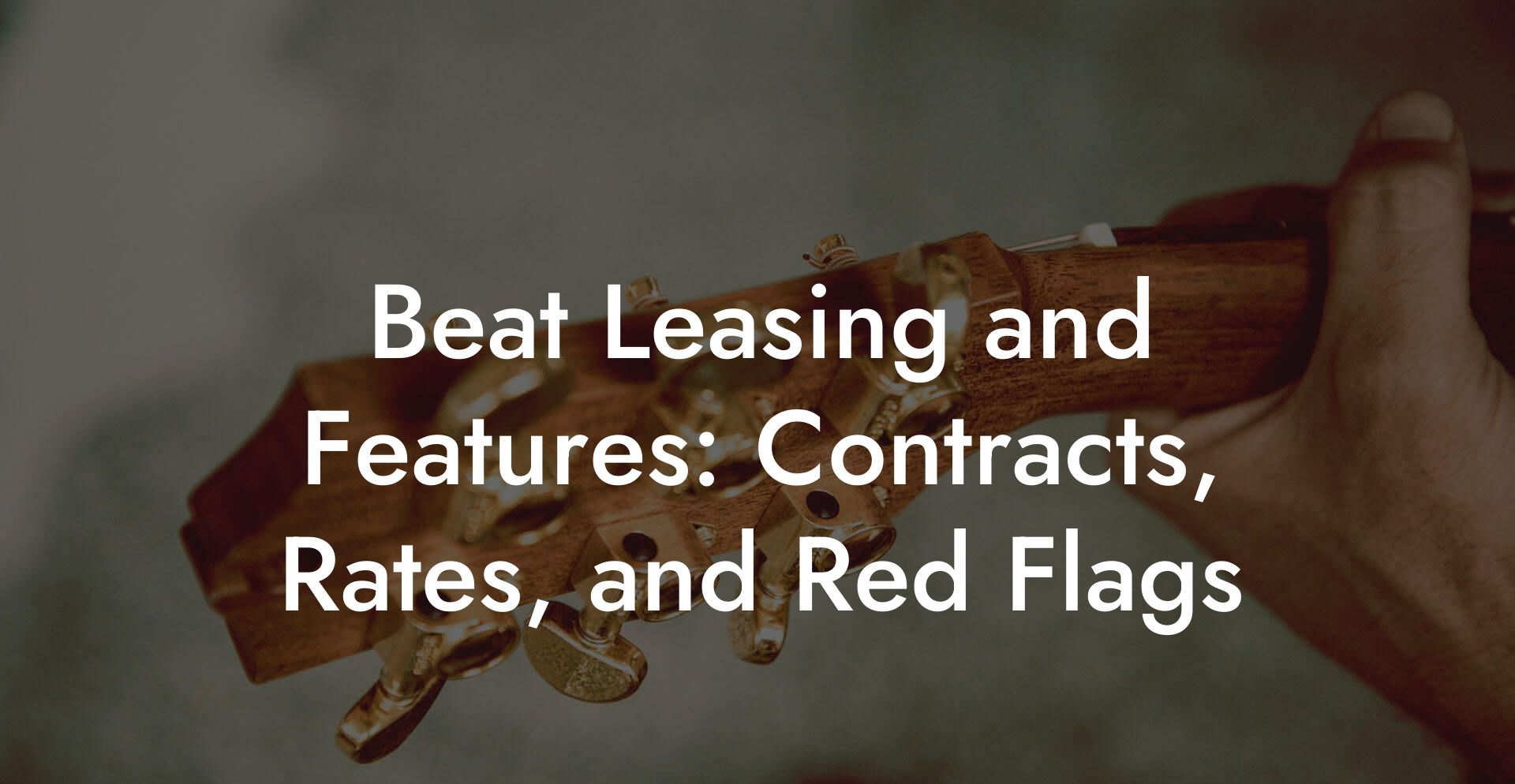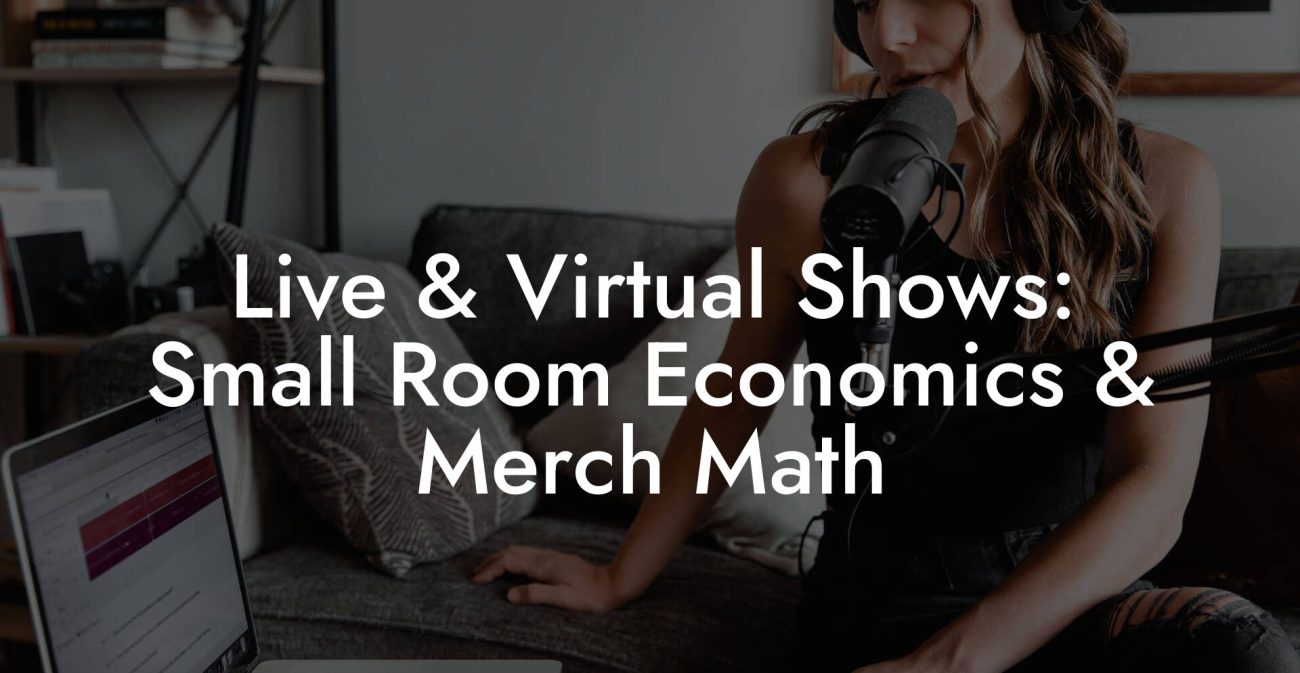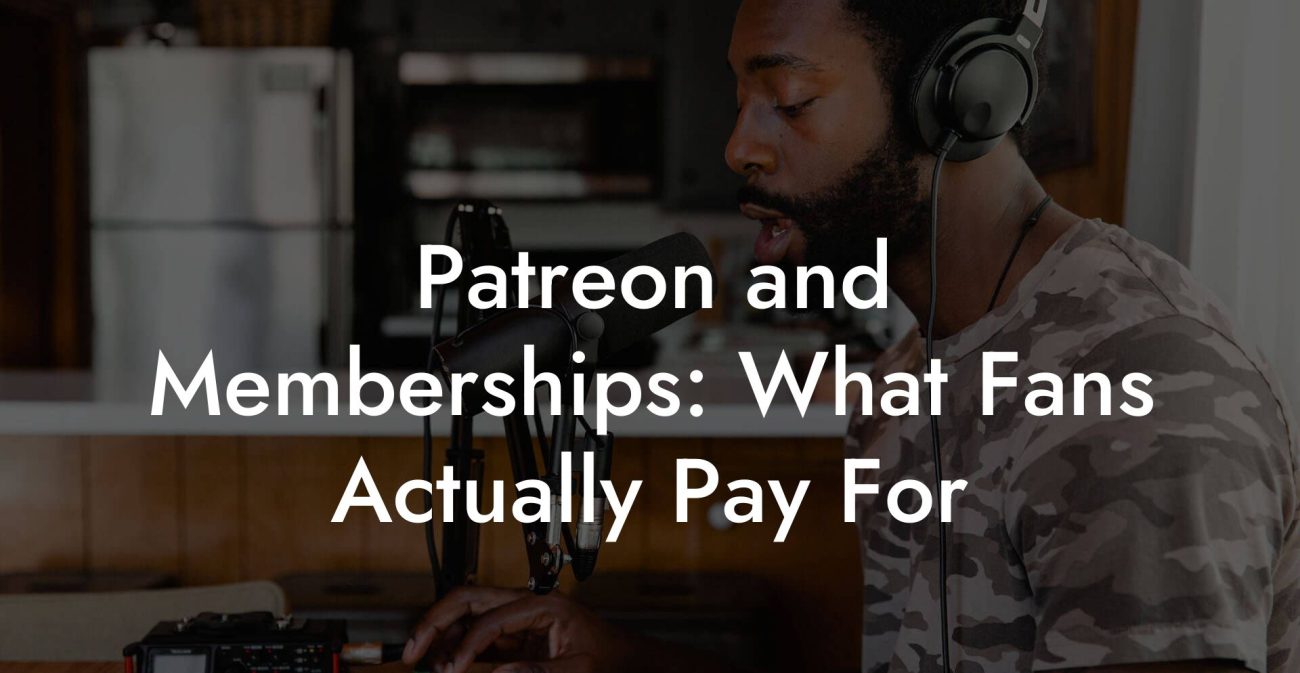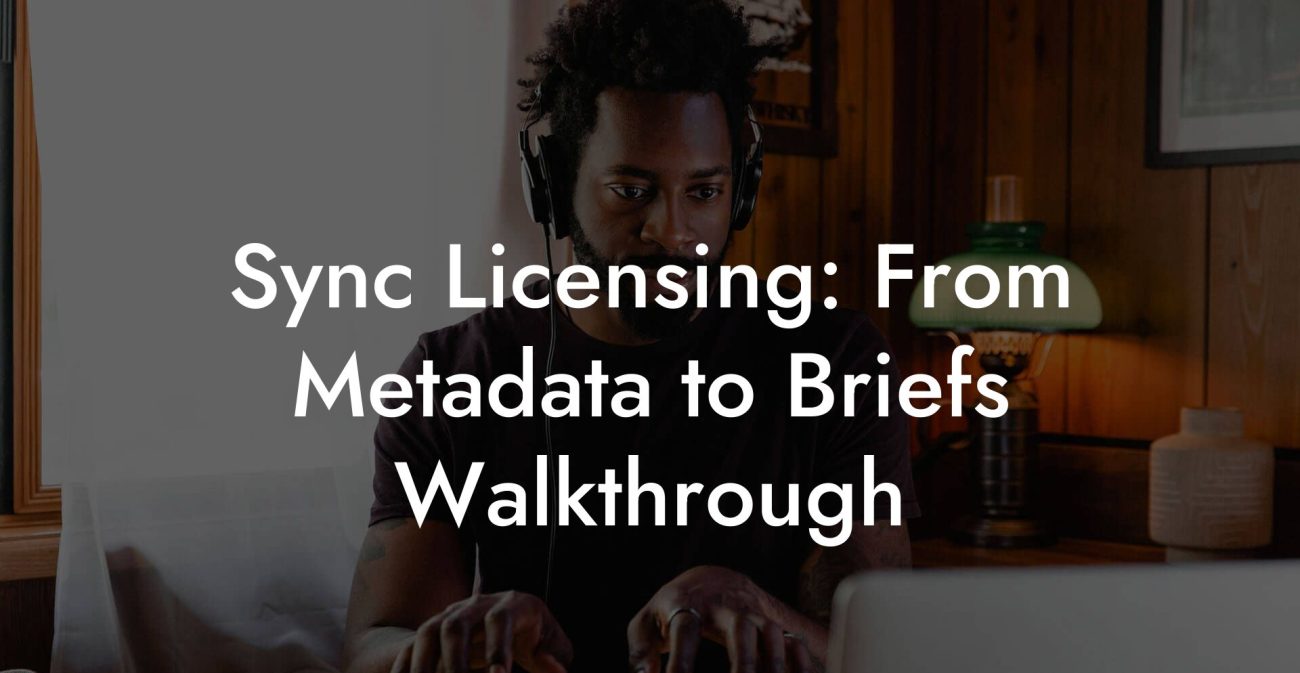Songwriting Advice
Beat Leasing and Features: Contracts, Rates, and Red Flags

You love that beat. You want the feature. You do not want to get screwed. Welcome to the merciless jungle of beat leasing and guest features. This guide gives you the language, the deal templates, and the street smart red flags you need to take your music career forward without giving away your future. We explain every term and acronym. We give real life examples you can nod along to. We will also be rude to bad contracts because somebody has to do the emotional labor of saying what you already think.
Quick Interruption: Ever wondered how huge artists end up fighting for their own songs? The answer is in the fine print. Learn the lines that protect you. Own your masters. Keep royalties. Keep playing shows without moving back in with Mom. Find out more →
Quick Links to Useful Sections
- Basics First What Is Beat Leasing Versus Beat Sale
- Common Licensing Terms You Must Know
- Typical Beat Lease Packages and Rates
- What Each Lease Should Say in Plain English
- Producer Splits and Publishing Points Explained
- Master Rights and Buyouts
- Feature Agreements What Artists Must Watch For
- Sample Clearance and Why It Destroys Careers If Ignored
- Common Red Flags in Beat and Feature Contracts
- Negotiation Tips for Producers and Artists
- How to Read the Key Clauses in a Beat License
- Grant of Rights
- Term and Territory
- Payment and Royalties
- Credits and Metadata
- Warranties and Indemnity
- Reversion and Termination
- How Splits Should Be Registered and Collected
- Sync Licensing Quick Guide
- Practical Contract Language Examples You Can Use
- Nonexclusive Unlimited License Example
- Exclusive Beat Sale Example
- Feature Agreement Example
- How to Use a Beat Store Safely
- What to Do If a Contract Goes Bad
- Checklist Before You Pay For a Beat or Feature
- Frequently Asked Questions
This is written for millennial and Gen Z artists who want clear rules, quick wins, and no legal XXL vocabulary. Read this and you will know the difference between a license and a sale. You will know reasonable rates and common fake promises. You will know how to protect your splits, metadata, credits, and future sync money. Bring coffee. Bring anger. Keep your receipts.
Basics First What Is Beat Leasing Versus Beat Sale
Beat leasing is a license that lets an artist use a producer made instrumental for a specified set of rights. The producer still owns the beat. The artist gets permission to record vocals and to distribute the recording under the license limits.
Beat sale or exclusive sale is when the producer transfers ownership or exclusive rights to the beat to one artist. The buyer gets exclusive control of the beat so the producer cannot license it to anyone else in the same way.
Real life scenario
- Producer posts a beat for sale on a beat store. A rapper pays for a nonexclusive license and uploads a video that gets a few thousand views. Later another rapper buys exclusive rights. The first artist keeps their recording but cannot claim the beat is exclusive or stop others from using it under the producer previous nonexclusive license.
Common Licensing Terms You Must Know
These are the contract vocabulary words that matter. If you do not see these spelled out, you do not have a deal.
- License A legal permission to use someone else work under stated conditions. Not the same as ownership.
- Exclusive Only one party may use the beat for the agreed categories for the length of the agreement. If the beat is exclusive the producer cannot license it again in the same way.
- Nonexclusive The producer can license the beat to multiple artists at the same time. Think common beat store purchases.
- Term The length of time the license is valid. Could be forever or for a set number of years.
- Territory Where the license applies. Worldwide is common. Limited territories are possible but weird in streaming era.
- Usage What the license allows. Streaming, YouTube monetization, sync for film or TV, radio, club performance and live play are different boxes that must be checked.
- Masters Ownership of the actual sound recording. Master owner controls the master recording rights and receives certain revenue streams from it. This is separate from publishing.
- Publishing Rights in the underlying composition meaning melody and lyrics. Songwriters and producers may own publishing points called splits.
- Split The percentage of publishing assigned to each contributor for the composition. Example 50 25 25 across writers and producer.
- PRO Performance Rights Organization. This is the company that collects public performance royalties for songwriters and publishers. Examples include ASCAP, BMI and SESAC in the United States.
- Sync Synchronization license which is permission to use the recording with visual media such as films ads and TV shows.
Typical Beat Lease Packages and Rates
Names for lease tiers vary by producer and beat store. The idea is the same. A basic lease costs less and limits the uses. A premium lease costs more and loosens limits. An exclusive sale is expensive and transfers exclusive use.
Typical price ranges in the market as of today
- Basic lease Usually between twenty and fifty dollars. Usually allows non commercial use or limited streaming and video plays. Good for demos social clips and artists testing the market.
- Standard lease Usually between fifty and one hundred dollars. Allows commercial release on streaming platforms with some cap on revenue or streaming numbers. May require producer credit and include basic monetization rights on YouTube.
- Premium lease Usually between one hundred and two hundred fifty dollars. Higher play cap or unlimited streaming in some offers. Better monetization rights and sometimes early sync consideration.
- Unlimited nonexclusive license Could be two hundred fifty to seven hundred fifty dollars. This implies no hard caps on plays or monetization while remaining nonexclusive.
- Exclusive beat sale Anywhere from five hundred to tens of thousands of dollars depending on the producer reputation and beat demand. Typical independent producer exclusive sales often fall between one thousand and five thousand dollars for serious artists. High profile producers can command far more.
Real life scenario
- New artist buys a basic lease for twenty five dollars to make an Instagram teaser. The beat is available to everyone else. The teaser goes viral. The producer later sells exclusive rights to another artist for two thousand dollars. This is legal because the first artist had a nonexclusive license only. The first artist keeps their recording but cannot claim exclusivity.
What Each Lease Should Say in Plain English
Every license should answer these simple questions. If the contract avoids them the contract is garbage.
- Who owns the beat after this deal
- Who owns the master recording after the vocal is added
- Do you get to monetize on streaming platforms and YouTube
- Are there any limits on plays or income amounts
- Is the license exclusive or nonexclusive
- Who gets publishing points and what are the exact percentages
- Does the producer get producer credit in metadata and in visual media
- Who is responsible for clearing samples
- How long does the license last and what happens after it ends
- Are there termination or refund policies
Producer Splits and Publishing Points Explained
Producer splits mean the producer is claiming a share of the songwriting composition. That share is separate from the master. If a beat has a composer portion such as a melody or chord progression the producer often asks for publishing points. A point is one percent of the publishing share of the composition.
Examples
- Artist writes lyrics and melody and producer created instrumental. A common split might be sixty percent to the songwriter and forty percent to the producer. That is expressed as sixty 40.
- If there are two writers and one producer a fair split might be fifty 25 25 depending on contributions and negotiation.
Why splits matter
- Publishing pays mechanical and performance royalties when the composition is played or reproduced. These are lifelong and can be significant if the song gains traction.
- If you sign away publishing for cheap you lose long term earnings from radio syncing covers and international plays.
Master Rights and Buyouts
Master rights are the rights in the recorded performance. Whoever owns the master controls licensing for sync deals in most cases and gets master royalties from services that pay the master owner.
If a producer sells the master to the artist for a one time fee the artist becomes owner and controls future master licensing. If the producer retains the master the artist may need permission to license the recording for sync or other commercial uses.
Be careful of phrases that sound like buyout but are not clear. Ask for explicit language that transfers ownership or grants exclusive control to the artist for the master and for what price.
Feature Agreements What Artists Must Watch For
A feature is when an artist contributes vocals or other creative parts to another artist recording. Feature deals can include payment upfront for the guest verse or a split of proceeds or both. Feature deals must handle credits metadata and splits the same way that producer deals do.
Key points for feature contracts
- Credit: how you will be credited on streaming platforms and on the cover art
- Payment: flat fee and or share of master and publishing revenue
- Usage: where the recording can be used and who can place it with sync users
- Exclusivity: can the featured artist perform the verse elsewhere or release the verse as a solo work
- Clearance: who clears samples and pays fees if the track contains third party samples
- Duration and reversion: does the feature agreement last forever or have reversion terms
Real life scenario
- A up and coming singer agrees to feature on a rapper track for five hundred dollars and promises of exposure. The track blows up and makes hundreds of thousands of dollars. Without a clear split the singer may have no claim on the money. A written agreement with either an upfront payment plus a percentage of master income or a publishing split would have protected the singer.
Sample Clearance and Why It Destroys Careers If Ignored
If the beat uses a sample that was not cleared legally you and the producer are at risk. Labels and publishers will sue or demand large settlements. You cannot rely on a producer oral claim that the sample is safe. Get it in writing and get clearance receipts if the sample is third party.
Sample clearance steps
- Identify composition owners and master owners of the sample
- Contact rights holders to request a license for the sample in the territory and media you plan to use
- Negotiate fees or splits and get a written license
- Keep the documentation safe in case of future dispute
Common Red Flags in Beat and Feature Contracts
There are shady moves that producers or artists will try to use. You will see these in DMs on social media and in poorly written contracts. Learn them so you can say no with style.
- Vague ownership language If the contract uses words like right to use without saying who owns the master you are missing something. Ownership must be clear.
- Unlimited use for unclear payment If the producer says you can use the track everywhere but there is no stated price or the price is buried in a link you will regret it.
- No metadata or credit clause If the contract does not say how you will be credited and what metadata will be submitted to streaming platforms you risk losing collection rights and dirty metadata that blocks payouts.
- Producer keeps all publishing but gets no actual contribution If a producer claims songwriting credits without contributing melody or chord structure challenge them hard. Credits must reflect real contribution.
- Auto renewal or rolling exclusivity A clause that allows the producer to convert the license to exclusive later without paying you is a trap. Exclusivity should be a paid and clear sale.
- Sample clearance left as artist responsibility without note on cost If you are told to clear samples for a beat you bought for thirty dollars know that getting proper clearance can cost thousands.
- No termination or refund terms Deals without clear termination rights will leave you stuck if the other party breaches.
Negotiation Tips for Producers and Artists
If you are the producer
- Offer clear lease tiers with written limits. Transparency reduces disputes and increases trust.
- Protect your publishing if you wrote the composition. Use percentage points and register splits with PROs at the time of release.
- Think about future sync. If you want a piece of sync fees state it. Sync fees can be lucrative and are often negotiated separately.
- If selling exclusive rights require a non refundable deposit to take the beat off the market while you finalize paperwork.
If you are the artist
- Insist on written license details. Screenshots of DM agreements will not do the job in a serious dispute.
- Keep budgets in mind. If a premium exclusive buyout is out of budget consider a strong nonexclusive unlimited license with clear monetization rights.
- Negotiate metadata credits and splits before you record vocals. Metadata forgetfulness eats money like a raccoon at a festival.
- Consider registering the song with your PRO early so that splits are officially recorded when income arrives.
How to Read the Key Clauses in a Beat License
Here are the contract clauses you should scan first and what they actually mean in normal talk.
Grant of Rights
This clause says what the producer is allowing you to do. Look for words like exclusive and nonexclusive. Check the list of uses included. If sync is not included and you want it add it and set a price or a future negotiation process.
Term and Territory
Term means how long the license lasts. Territory is where it applies. In streaming times a worldwide and perpetual license is common for exclusive sales but for nonexclusive leases the term can be limited. If the term ends make sure you know whether your already released recordings can stay up and who owns them.
Payment and Royalties
Clear payment methods and any royalty splits must be spelled out. If the producer asks for a share of master sales or streaming ask for exact percentages and how they will be paid. If you agree to splits add a paragraph on how accounting is done and timing for payments.
Credits and Metadata
Insist on exact credit language for streaming and all visual media. Also demand the correct metadata to be submitted to distributors and PROs. Bad metadata equals lost money and invisible contributors.
Warranties and Indemnity
The warranty clause is where each party promises that they have the right to license the material. Avoid contracts where the producer disclaims all responsibility for samples and writer authorship. Indemnity clauses that force you to pay all damages if a claim arises are risky. Balance liability or get insurance.
Reversion and Termination
Know how to end the deal if the other party breaches. If you buy exclusive rights you want a clause that requires the producer to remove the beat from other public stores on receipt of payment. If the producer fails to remove it you want a refund or additional compensation.
How Splits Should Be Registered and Collected
Register the splits with your distributor and with your PRO before release. If you do not register publishing splits many platforms and collecting societies will assume default splits that may not reflect your agreement.
PRO registration steps
- Agree split percentages in writing with all songwriters and the producer
- Register the song with the PRO for each writer and publisher share
- If you use a third party publishing administrator register the publishing share and give them admin rights to collect mechanical and performance money globally
Real life scenario
- An artist releases a song that becomes a club hit. The producer was never registered with a PRO. The producer sits on the side while tens of thousands of streams are collected by platform services. The producer later asks for money but the registration window means mechanical and performance money was difficult to trace. Simple PRO registration would have prevented the drama.
Sync Licensing Quick Guide
Sync licensing is when a song or recording is placed with a visual. There are two pieces to clear for sync. You need a license for the composition and a license for the master recording. The sync fee often splits between the publisher and the master owner. Producer involvement depends on splits and master ownership.
If you do not own the master or publishing you need permission from those owners to clear sync. If the beat producer still owns the beat you need their signed permission. If the producer sells you exclusive rights but retains publishing points or master percentages you will still need coordination for sync deals.
Practical Contract Language Examples You Can Use
These are plain speak examples you can paste into an email or into a contract with names changed. Use a lawyer for major deals but these snippets protect you in common scenarios.
Nonexclusive Unlimited License Example
The producer grants the artist a nonexclusive worldwide license to use the instrumental in the artist sound recording and to distribute that recording on digital platforms including streaming and paid download. The license is perpetual for the recorded version created by the artist. The producer retains ownership of the underlying instrumental. The artist has the right to monetize the recording on YouTube. The producer will be credited as producer in the recording metadata as Producer Name. The producer receives zero percent of the master revenues unless otherwise agreed in writing. Publishing splits remain as agreed in the attached split sheet.
Exclusive Beat Sale Example
Upon receipt of payment the producer transfers exclusive rights to the instrumental to the buyer including the right to register and control both publishing and master rights for the buyer recordings using the instrumental. The producer will remove the instrumental from public sale and licensing within two business days of payment confirmation. The producer retains the right to be credited as original producer. Any third party sample clearances are represented as cleared by the producer as stated in the attached clearance documentation.
Feature Agreement Example
The featured artist shall perform vocal parts for the master recording. The featured artist will be credited as Featured Artist Name on streaming platforms. The featured artist shall receive a one time fee of Amount plus Percent percent of net master income after distribution fees. Publishing splits for composition will be split as follows Artist A Percent Producer Percent Featured Artist Percent. Any sync licensing requires written consent of all publishing owners. Each party will register their share with their PRO within thirty days of release.
How to Use a Beat Store Safely
Beat stores are convenient but they are also where sloppy contracts live. Always read the license text before you click purchase. If the license language is missing or unclear contact the producer. Ask for a written contract template that includes credit and usage clauses.
If you are an artist on a tight budget consider these options
- Buy a nonexclusive unlimited license and negotiate a modest publishing split if the producer asks for points. Often a fair split for a new producer is twenty five to thirty three percent depending on contribution.
- Use a producer who offers exclusive sales for a reasonable price and get everything in writing including removal from sales and transfer of files and metadata.
- Use the beat as a demo first and only commit to paid release after you confirm metadata and registration steps are in place.
What to Do If a Contract Goes Bad
First breathe. Then follow these steps
- Gather all written communications purchase receipts and registration records
- Contact the other party and request correction or refund in writing. Be specific about the remedy you seek
- If the dispute is about money or metadata contact the distributor and your PRO to lock registration and to note the dispute
- If necessary consult a music attorney. For small dollar disputes a demand letter from an attorney can often resolve things. For big disputes get counsel immediately.
Checklist Before You Pay For a Beat or Feature
- Do you have written license terms and a copy saved
- Is exclusivity clear and paid for if promised
- Are publishing splits agreed in writing and registered with PROs
- Is the sample clearance documented if applicable
- Is the master ownership defined
- Is credit and metadata language specified exactly
- Are payment and refund terms stated
- Is there a termination clause and does it protect you
Frequently Asked Questions
Can I legally sell beats if I used a sample
Not safely unless you cleared the sample. Sample clearance requires permission from the owners of the composition and the master recording that you sampled. Clearance can be expensive and sometimes impossible. If the sample is not cleared you risk takedown notices or lawsuits. Always document clearance in writing.
Do I need a contract for a feature if the guest is my friend
Yes write it down. Verbal promises break faster than collaborations do. A simple written agreement that covers payment credits splits and rights prevents fights down the road. Friendship alone is not a legal defense.
Can a producer take back an exclusive beat after they sold it to me
Not if the sale transferred exclusive rights and the payment was made. The contract should include language that the producer will remove the beat from public sale and will not license it again. If the producer attempts to take it back you may have a claim for breach of contract.
How much publishing should a producer get
There is no one right answer. For a beat where the producer created the entire instrumental many producers ask for between twenty five and fifty percent publishing. If the artist wrote major melodic elements the producer share might be lower. Negotiate and base splits on real contributions. Always put the agreement in writing and register with PROs quickly.
What is a split sheet and why do I need one
A split sheet is a simple document that lists each writer and the percentage of publishing they will receive. It is crucial for registering with PROs and for clear future payments. It prevents unpleasant surprises when money starts flowing.




